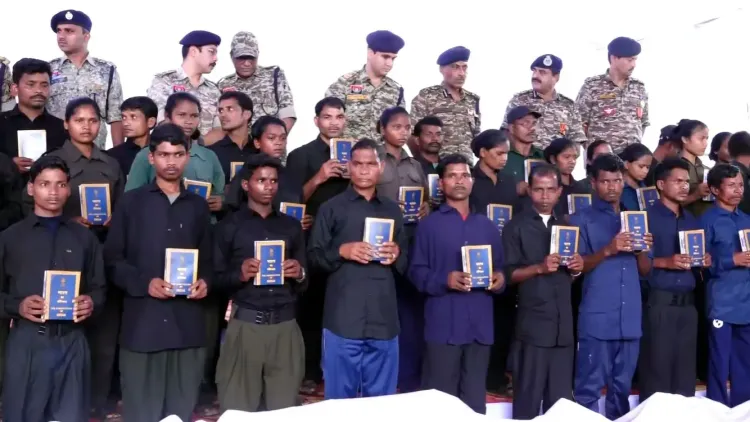What Does the Historic Surrender of 208 Maoists in Chhattisgarh Mean for the Region?

Synopsis
Key Takeaways
- 208 Maoists surrendered in a historic event.
- The surrender signifies a major setback for the insurgency.
- Chief Minister Vishnu Deo Sai emphasized rehabilitation and democratic values.
- The surrenders included 110 women and 98 men.
- A total of 153 weapons were relinquished, including high-caliber rifles.
Jagdalpur, Oct 17 (NationPress) In a historic event that highlights a significant blow to the insurgency in Chhattisgarh, a total of 208 Naxalites from the isolated Maad region officially surrendered on Friday in the presence of Chief Minister Vishnu Deo Sai and Deputy Chief Minister Vijay Sharma, who participated remotely from the Reserve Police Lines in Jagdalpur, located in Bastar district.
The former militants, many of whom had been entrenched in the Dandakaranya forests for years, arrived holding copies of the Indian Constitution, signifying their dedication to democratic principles, accompanied by banners that read 'Puna Margem'—a new journey towards rehabilitation. This group surrendered a considerable collection of 153 weapons, which included 19 AK-47 rifles, 17 SLR rifles, 23 INSAS rifles, one INSAS light machine gun, 36 .303 rifles, four carbines, 11 barrel grenade launchers, 41 12-bore single-shot weapons, and one pistol.
This mass surrender comprises 110 women and 98 men, including prominent figures such as one Central Committee Member (CCM), four members from the Dandakaranya Special Zonal Committee (DKSZC), one Regional Committee member, 21 Divisional Committee Members (DVCM), 61 Area Committee Members (ACM), 98 grassroots cadres, and 22 members from the People's Liberation Guerrilla Army (PLGA) or Revolutionary People's Council (RPC). Among the notable individuals is Rupesh, also known as Satish or Asanna, the North-West Sub-Zonal In-charge and a senior commander within the CPI (Maoist) northwest sub-zonal bureau.
Rupesh, recognized as the intelligence chief of the Maoist military faction and a notorious bombmaker (full name Takkalappalli Vasudeva Rao, aged 59), along with his comrades, made an initial surrender at the Bijapur police headquarters on Thursday evening.
His defection, alongside others like woman commander Ranita from the Maad division, signifies a substantial disruption to the Maoist leadership structure in the area.
Chief Minister Sai commended the surrender as a pivotal moment in Bastar's campaign against extremism, stressing that the region's true power rests in its people's self-sufficiency, education, and dignity.
“Our governance model, grounded in these values, is currently fostering hope and transformation in the heart of Dandakaranya,” he remarked.
The Chief Minister also pointed out that north Bastar and Abujhmad have been declared entirely free from Naxalism, marking a transition from violence to optimism.
Under the BJP government, over the past 22 months, 477 Naxalites have been neutralized, 1,785 arrested, and 2,110 surrendered, emphasizing the state's advancement towards achieving a Naxal-free Chhattisgarh by March 31, 2026.









